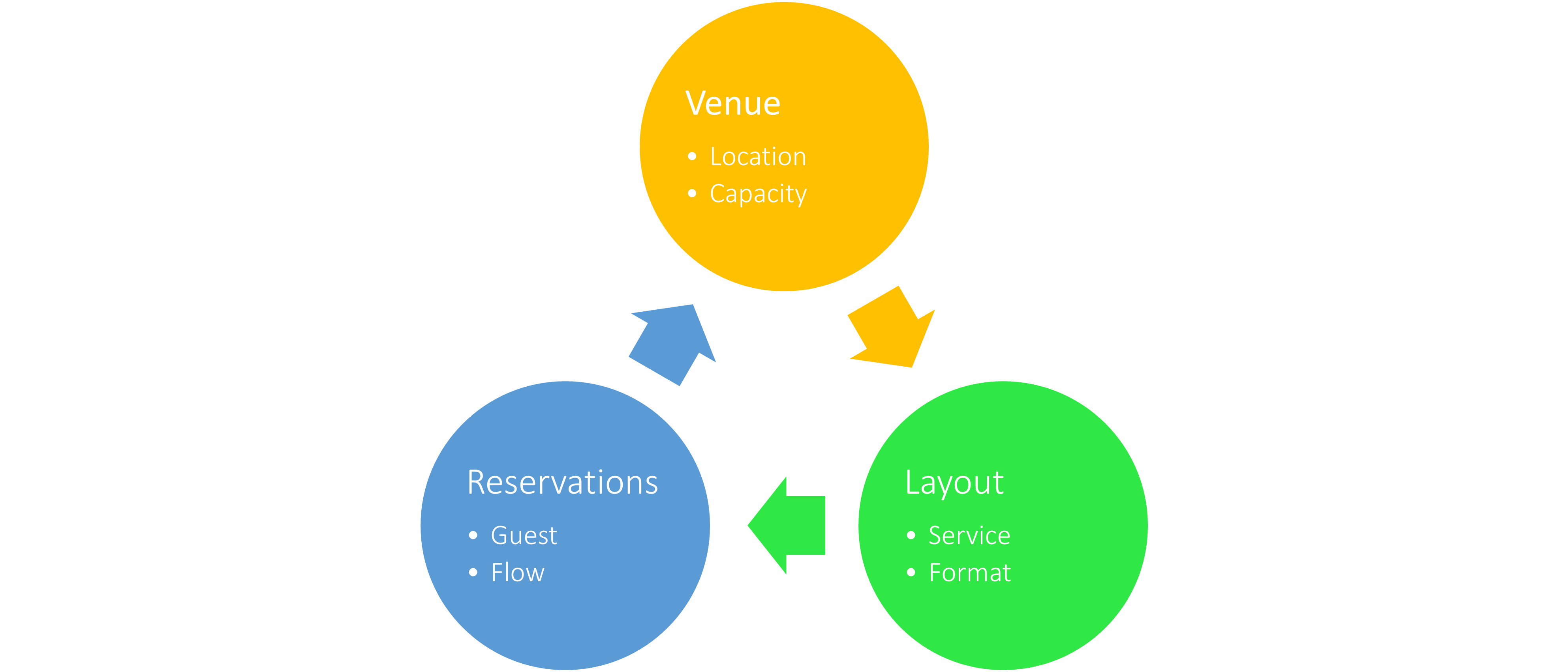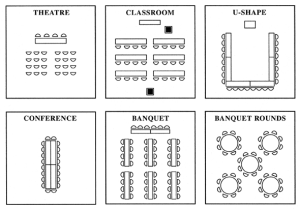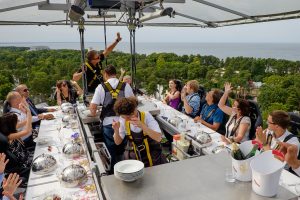Chapter 9 – Venue, Layout and Reservations
Pauline Milwood
Whenever you enter into the planning process for an event—whether a corporate function, wedding or fundraiser—it’s very important to identify not only your objectives and goals, but also the type of setting where you envision your event taking place. The most perfectly executed plan may get lost if the location doesn’t function properly both aesthetically and logistically.
—Wendy McCool, The Art of Event Planning
Learning Objectives
At the end of this chapter, students will be able to do the following:
- Understand and apply the venue-layout-reservations relationship to the pop-up management plan
- Understand and observe venue operating laws and guidelines for pop-up events
- Conduct effective venue audits of production areas for pop-ups
- Conduct effective venue audits of service areas for pop-ups
- Understand venue and layout types for venue management
- Create a reservation or booking system for receiving dinner requests
- Create venue layout plans for production and service areas for staging a pop-up restaurant
Chapter Warm-Up
Prechapter Reading Materials
- “Pop-Up Restaurants: Seasonality, Types of Spaces, and Other Factors” (Baras 2015)
- “Event Venue Satisfaction and Its Impact on Sponsorship Outcomes” (Michelini, Iasevoli, and Theodoraki 2017, 322–23)
Prechapter Exercises
- Consider the following quote from Michelini, Iasevoli, and Theodoraki (2017) on the concept of the “plurality” of event venues: “Some event venues are temporarily erected,…and then transported to other spaces, or dismantled and discarded after use, or leased to another event. Furthermore, event venues can refer to different contexts, such as hospitality, tourism, leisure, and sport.” In groups of two to three persons, discuss the concept of “plurality” and its implications for venue planning for your pop-up restaurant.
- Conduct a walk-through of the locations where previous pop-up restaurants have been staged on the Penn State Berks campus. What are some advantages and disadvantages of each of these spaces?
Chapter Outline
- The Venue-Layout-Reservations Relationship
- Conducting a Venue Audit
- Types of Venue Layout
- Reservation Systems and the Role of Technology
The Venue-Layout-Reservations Relationship
There is an important relationship between the venue, layout, and reservation characteristics associated with the development of the pop-up restaurant plan. Venue capacity, referred to as the legal limit of the amount of per-person space (in sq. ft.) designated to an area, determines the maximum number of guests allowable per sitting. This number will impact directly the number of reservation requests allowable for dine-in guests based on the layout selected (e.g., ballroom-, banquet-, cocktail-, theater-style seating). Figure 9.1 shows the relationship among venue, layout, and reservations.

Figure 9.1 – The venue-layout-reservations triad
It is important for the hospitality manager to conduct a physical walk-through—in fact, several walk-throughs—of the proposed pop-up restaurant venue as part of putting together a venue layout plan. The venue layout plan will include production (BOH) and service (FOH) considerations.
Venue planning involves giving consideration to BOH, FOH, and exchange paths that will be utilized to ensure the smooth and seamless flow of production and service functions on the night of the pop-up experience. While each area is run by separate management teams during production and service, a thorough understanding of BOH, FOH, and planning for exchange paths is critical for the proper overall functioning of production-service processes. Giving consideration to how the venue can be used across all three functions ensures an efficient flow of service for diners as well as a safe workflow for both diners and workers.
Conducting a venue audit
When conducting a venue audit, the following considerations should be evaluated for both availability and accessibility.
- Production areas of the venue
- Food and beverage receival and storage
- Food and beverage preparation
- Plating and expediting
- Food-production equipment (capacity, capability)
- Employee restrooms
- Service areas of the venue
- Food and beverage service
- Guest pathways (entry, exit)
- Guest restrooms
- Employee pathways
- Table settings
- Other factors
- Accessibility
- Emergency and support facilities
- Licenses
- Maintenance and operations
- Permits
Exercise 9.0: Restaurant-within-a-Restaurant (Adapted, Baras 2015)
Most restaurants tend to operate during shortened daytime hours. A restaurant that specializes in dinner rarely is open for breakfast and lunch as well. Conversely, a restaurant that is open for breakfast and lunch is often closed for dinner. Additionally, many restaurants are closed one to two days a week—for example, a restaurant that caters to the daytime office crowd is often closed during the weekends. Many restaurants that specialize in dinner are closed on Mondays, customarily the slowest day of the week for dining out. And many restaurants close by no later than 10 p.m.
But the clock keeps ticking when it comes to the restaurateur’s fixed costs, whether the restaurant is open or closed. Each second of the day costs the proprietor rent, insurance, license fees, and other attendant costs.
Second, from the perspective of the pop-up restaurant merchant, there are more complexities for an entrepreneur who is looking to host a pop-up restaurant than for one wanting to open a pop-up store. A pop-up dining host needs kitchen-prep facilities and cooking equipment. He needs tables, chairs, linens, and even dishes and flatware. Perhaps most challenging of all, he needs to have a space that is compliant with local health department ordinances.
These are all challenges from two opposite perspectives, but they can be met by a restaurant-within-a-restaurant arrangement.
Critical Thinking Questions
- How can a restaurant-within-a-restaurant strategy help with finding an appropriate venue for a pop-up restaurant?
- What are some challenges associated with a restaurant-within-a-restaurant strategy?
- What are some benefits associated with a restaurant-within-a-restaurant strategy?
Types of venue layout
As discussed above, the venue for your restaurant will directly influence the layout style and format of your pop-up restaurant. Figure 9.2 provides examples of venue layout options. Which layout(s) do you think are popularly used in food-service settings?
Figure 9.2 – Types of venue layout

Typically, restaurants follow banquet or cabaret layouts. However, other layouts are widely accepted and are driven by the tastes, budget, and creativity of the popupreneur. In the chapter warm-up, we read of Chef Ludo Lefebvre’s out-of-this-world pop-up dinners, some of which are staged (quite literally) thousands of feet aboveground! The venue layout appropriate for Lefebvre’s pop-up in the sky might be referred to as a hollow square and is an appropriate layout for the small number of diners at any given time as well as the novel logistic of being suspended by cable thousands of feet aboveground

Image credit: “Dinner In The Sky, Māris Jansons” by Kārlis Dambrāns via flickr under CC BY-NC 2.0.
Other layout styles may be driven by efficiency, break-even points, available seat hours, and capacity limits. Capacity limits have become increasingly important in the post-COVID-19 era. Another consideration may be related to the overall theme of the event. For example, a pop-up restaurant featuring dinner theater or the performing arts might be best suited for a classic banquet-style, U-shaped, or theater-style layout. Another pop-up restaurant that features art may be themed around tasting plates and bistro-style seating/standing combination layouts.
Reservation systems and the role of technology
Reservation systems can vary from a simplified logbook used to enter reservations received via telephone or email to a fully automated system such as a mobile application that facilitates the placement and receipt of reservations. Recently, technology-mediated platforms have increased exponentially in popularity. These platforms facilitate intermediated communication and engagement with potential customers. In the case of a pop-up restaurant, prospective diners are able to place reservations via technological or nontechnological systems. It is up to the hospitality manager to determine which medium best suits the target market of potential customers, though restaurants will usually provide more than one way for customers to place reservations in the event one system collapses.
The rise of mobile technology has revolutionized the way in which hospitality service providers such as restaurateurs are able to communicate and engage with current and prospective customers. Mobile telephones, supported by ubiquitous technology platforms, apps, and Wi-Fi, allow direct communication between restaurants and customers and between customers and other customers. For example, online rating systems allow customers to view what other customers have to share about their experiences at a particular service establishment without having to rely on the establishment’s website. In the same manner, restaurants are able to reach and hear from their target market because of direct-channel mobile technology platforms and social media. (Social media marketing is further exploredd in chapter 4.)
There are several ways in which restaurateurs can facilitate guest reservation requests by the use of technology. One example is a QR code. A QR code is used to embed information safely and conveniently for use by customers, guests, or other stakeholders. Presented as a square-shaped box of black-inked pattern markings, a QR code carries bidimensional information that, when accessed with a camera or other scanning device, opens links to embedded content. Another example is the use of URLs, or uniform resource locators, which redirect users to a prespecified location of web-based information. Presented as hyperlinked text, guests are able to access this information by being redirected to its source, normally housed on the internet.
KEY TERMS
- Venue layout
- Landlord licenses
- Liquor license
- Permits
- QR code
- Reservation systems
REVIEW Questions
- How can your understanding of the venue-layout-reservations relationship be applied to a single-night pop-up restaurant event?
- What are three advantages of using an automated reservations system?
- What are three disadvantages of using an automated reservation system?
- Why would (production) kitchen layout/location be an important consideration for FOH planning? Why would (service) dining layout/location be an important consideration for BOH planning?
Review Activities
- Using your camera phone or another appropriate scanning device, scan the following QR code. What message is embedded in the code?

- Using the link to the QR Code Generator, practice creating your own QR code.
- Read the article in exercise 9.1. Using your favorite internet browser, search for a restaurant in your local community that serves only breakfast and/or lunch. Could any of these restaurants serve as a venue for a pop-up restaurant? Share your results with the class.
Pop-up Project Task(s)
- Provide an overview of your plan for gathering guest feedback.
- Provide an overview of your venue, layout, and reservations plans.
Resources
Chapter References
Banquet Tables Pro. 2021. “Banquet Setup Diagrams Setup & Capacity Guidelines.” Accessed April 14, 2022. https://www.banquettablespro.com/banquet-table-setup-diagrams.
Baras, Jeremy. 2015. PopUp Republic: How to Start Your Own Successful Pop-Up Space, Shop, or Restaurant. Hoboken, NJ: Wiley. https://learning.oreilly.com/library/view/popup-republic/9781119145912/ (Penn State–authenticated link).
Feingold, Jeff. 2018. “The Art of Successful Event Planning.” New Hampshire Business Review 40 (18): 22. https://www.nhbr.com/the-art-of-successful-event-planning/ (Penn State–authenticated link).
Michelini, Laura, Gennaro Iasevoli, and Eleni Theodoraki. 2017. “Event Venue Satisfaction and Its Impact on Sponsorship Outcomes.” Event Management 21 (3): 319–31. https://doi.org/10.3727/152599517X14942648527536 (Penn State–authenticated link).
URLs, or uniform resource locators, are Internet locations or addresses which include a domain name and path.

